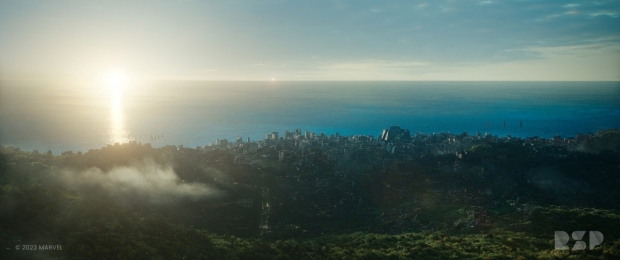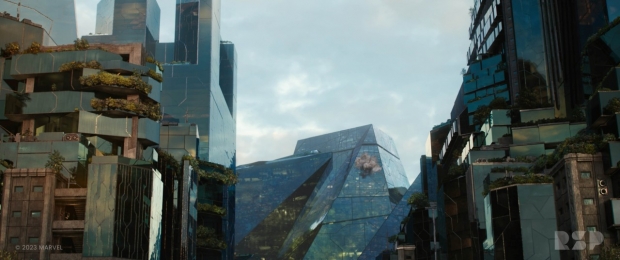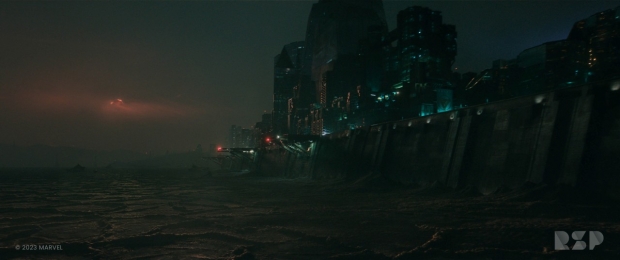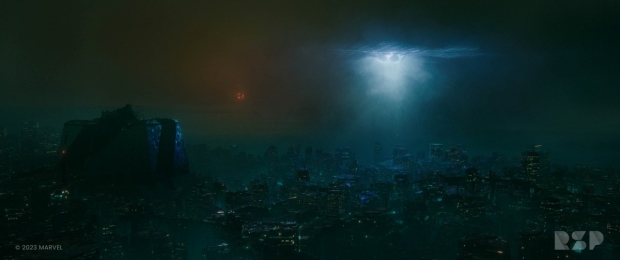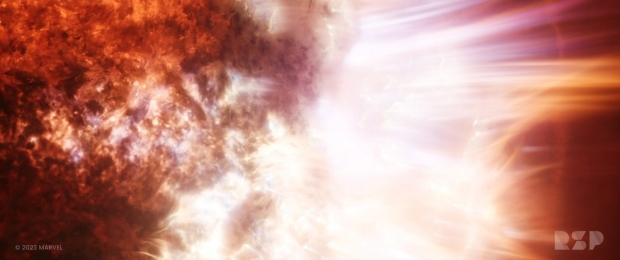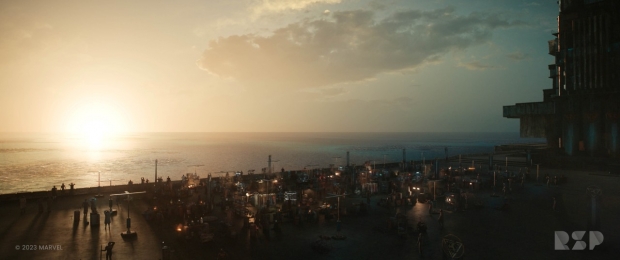The VFX studio tackled numerous large digital assets, creating the planet Hala and its vast city, taking it from brilliance to ruins, with the Sun’s initial luminous implosion and, ultimately, its miraculous rebirth.
For Marvel Studios' recent superhero adventure, The Marvels (sequel to 2019 Captain Marvel), Rising Sun Pictures (RSP) created a vast city on planet Hala, home to the Kree Empire and its artificial intelligence ruler, the Supreme Intelligencer. Artists created a representation of the futuristic city at the height of its power and as a devastated ruin. The studio also produced the film’s opening and closing sequences showing Hala's sun's luminous implosion and miraculous rebirth.
The Marvels is directed by Nia DaCosta and stars Brie Larson, Teyonah Parris, Iman Vellani, Zawe Ashton, Gary Lewis, Seo-Jun Park, Zenobia Shroff, Mohan Kapur, Saagar Shaikh, and Samuel L. Jackson. Rising Sun Pictures worked under the supervision of production Visual Effects Supervisor Tara DeMarco.
The movie marks the return of Carol Danvers/Captain Marvel (Larson), who has reclaimed her identity from the tyrannical Kree and taken revenge on the Supreme Intelligence. After traveling through a wormhole, she finds her powers entangled with those of Jersey City super-fan Kamala Khan, aka Ms. Marvel, and Carol’s estranged niece, now S.A.B.E.R. astronaut Captain Monica Rambeau, who join her in saving the universe.
Hala’s capital first appears in a flashback, a densely packed urban environment of towering skyscrapers and elegant homes arrayed along a crystal blue ocean.
“The skyline suggests Manhattan as it might look in some distant future,” said RSP VFX supervisor Jamie Macdougall. “It’s filled with beautiful architecture and surrounded by lush forest.”
The studio developed the city's look from concept art provided by the production. CG supervisor Prema Paetsch described, “We extrapolated on the drawings to produce a cityscape of thousands of buildings. Our first task was to define the city’s superstructure and then fill it with a logical distribution of office buildings, elevated roadways, residential structures, and landmarks. We also added human-scale details such as doors and windows, rooftop gardens, and trees. The challenge was to sell the size and scope of the city and to make it stylistically consistent without repeating patterns.”
“It’s one of the largest environments we’ve ever built,” added Macdougall. “And it has enough detail to be viewed from any camera angle or perspective. It’s seen in flyovers. The camera also drops down to street level so that you can look into individual homes and offices and see things like lighting fixtures and furniture.”
Particle effects were used to bring the city to life, comp supervisor Neill Barrack explained, “We designed systems that could be attached to tiny vehicles to make them move along roads and skyways in a logical manner. A similar technique was used to make birds fly gracefully past camera.”
The flashback ends with Captain Marvel destroying the city, including an immense green building housing the Supreme Intelligence.
“We see her attacking the Supreme Intelligence, which appears as a giant, anthropomorphic computer,” continued Macdougall. “It explodes with the blast spreading across the city. The next time we see the city, it’s a smoldering ruin. There is no water. The atmosphere has turned to poisonous smog. Its sun is dying.”
Artists added subtleties to suggest that the city has decayed over several decades. Paetsch noted, “Buildings are weathered, grimy and dirty. What used to be clear glass is smudged. Metal objects have rusted. We added skeleton trees to rooftop gardens and withered plants to balconies. Smoke lingers in the air. Everything is dark and gloomy.”
Paetsch described challenges the team encountered working with such large assets, noting, “We had a large team working on the environment together. We managed the load by distributing sub-assets and sub-structures to individual artists across several departments. The environments team focused on the procedural, rule-based design, while the assets team focused on bespoke hero structures that are seen close-up and needed very specific designs. We ultimately had hundreds of sub-assets that could be checked out as modules and checked back into the master system. The core of it all was a distribution logic that placed individual structures into the larger expanse in a defined order.”
Near the film's end, Captain Marvel uses her powers to restore the city to its former splendor, explained Macdougall, adding, “Massive winds blow through, bringing fresh air and pushing out the smog. Water is pumped in. The buildings are still destroyed, but it’s evident the planet is on the mend.”
The studio also created an impressive solar collapse and restoration that bookended the film, bringing in a science advisor to offer insight into how stars die.
“Quite a lot of thought went into how it should happen,” recalled Macdougall. “As the star dies and loses its fuel, it grows bigger and bigger before gravity kicks in, and it implodes. This process occurs over vast timeframes, but since the imminent death of the sun is an important story point, our task was to take this concept and imagine it in a way that conveyed urgency. It provides weight and drama to Captain Marvel’s mission.”
At the end of the film, the process is reversed. Captain Marvel uses her expanded powers to restart the sun. Paetsch explained that it was important that this spectacular transformation also appear convincing.
“It took a lot of conceptual work and experimentation with different approaches to three-dimensional simulations,” shared Paetsch. “There were multiple layers, complex details, and structures within structures, all of which are moving.”
“She [Captain Marvel] disappears into the sun, which is heated to millions of degrees, and our job was to make the audience believe that she is causing its regeneration to happen,” noted Barrack. “You see her energy beams emanating through the gaps and rippling across the solar surface as the crumbling structure fixes itself. It becomes smooth and beautifully bright. The team did a marvelous job in creating something that has never been seen before.”
The restoration of the sun gives way to a climactic view of the Hala capital once again bathed in light.
“Hero shots like these are a wonderful opportunity for our team to shine,” concluded Macdougall. “Both the cityscape and the solar sequences were massive in size and scope. They challenged our ability to solve problems and gave us a chance to flex our creative muscles. The results look fantastic.”
Source: RSP


